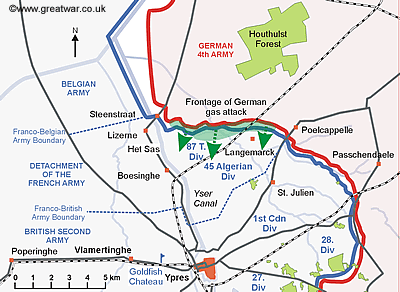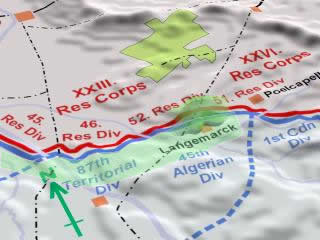 “Un nuage jaune-vert”: A yellow-green cloud engulfs the French
“Un nuage jaune-vert”: A yellow-green cloud engulfs the French
22 April 1915: 17.00
The French Official History describes the gas as “un nuage jaune-vert” - a yellow-green cloud:
“A yellow-green cloud [un nuage jaune-vert], pushed along by the wind, rolled towards our trenches, followed by German troops in dense formations.” (1)
At five o'clock the Germans opened the valves of the gas cylinders for approximately five minutes. The cloud moved before a gentle northerly breeze at a rate of about two metres per second (four to five miles an hour).(2)

General Foch Describes the Gas Attack

A message telephoned from the commander of the Groupe Provisoire du Nord, General Foch, to the French Commander in Chief, General Joffre, at 9.30pm on 22 April, described the surprise of the German attack and the first use of poisonous gas as a weapon of warfare on the Western Front as follows:
“Last evening brought with it a sharp and shocking surprise. The Germans sent a copious amount of suffocating gas, which spread its effect for more than a kilometre along the whole of the front Steenstraat - Langemarck and further to the east. At 17.00 hours our territorials [87th Division] in the area of the Triangular Wood [east of Lizerne on eastern Yser Canal bank] were completely asphyxiated in the whole of the front line position and the survivors surged back to Boesinghe. The occupants of the second position, who were less tested by the effect of the gas, nevertheless abandoned the Boesinghe bridgehead and the artillery positioned there and crossed the Yser Canal to the western bank. The number of weapons lost as a result of the withdrawal is not known.
At the same time our regiment of Tirailleurs of the 45th Division in the line at Langemarck lost this region with serious casualties and retired in the direction of the south-east of Boesinghe [remaining on the eastern bank of the canal].” (3)
The “abandoned” artillery referred to above was the French Artillery Group east of Boesinghe, which consisted of about 20 guns: 2 batteries of 90mm guns, 2 batteries of 75mm guns and 1 battery of 95mm guns.
A Gaseous Odour Reaches Vlamertinghe
The characteristic pungent odour of chlorine was soon noticed even at Vlamertinghe, several kilometres behind the lines. At the British V. Corps report centre [forward command headquarters] at Goldfish Chateau (1,800 metres west of Ypres railway station) there was a peculiar smell in the air; it caused smarting of the eyes and tingling in the throat. It was some time, however, before it was realised that the yellow clouds were due to the gas, about which warnings had been received during the previous few weeks.

Almost at the same time as the peculiar smell was noticed in the Vlamertinghe region, stragglers from the French 87th Territorial Division appeared there. Struggling for breath they sobbed “Pauvre France! Pauvre Paris!” — “Poor France! Poor Paris!” (4). French coloured troops were also seen in the British V. Corps rear area, drifting down the roads without officers. It was apparently impossible to understand what the African troops were saying and they were coughing and pointing to their throats. Behind the retiring infantry came teams and wagons of French field artillery. Some individuals were running and the growing throng of fugitives gradually became more disordered. Although French 75mm guns could still be heard firing, it was obvious to those who saw this spectacle in the V. Corps rear area that something very serious had happened in the French front line.(5)
Three months later, on 15th June July 1915, the Commander-in-Chief of the British Army, Field Marshal Sir John French, wrote in his despatch to the Secretary of State for War:
“Following a heavy bombardment, the enemy attacked the French Division (sic Divisions) at about 5p.m., using asphyxiating gases for the first time. Aircraft reported that at about 5p.m., thick yellow smoke had been seen issuing from the German trenches between Langemarck and Bixschoote. The French reported that two simultaneous attacks had been made east of the Ypres-Staden Railway, in which these asphyxiating gases had been employed.
What follows almost defies description. The effect of these poisonous gases was so virulent as to render the whole of the line held by the French Division mentioned above practically incapable of any action at all. It was at first impossible for anyone to realize what had actually happened. The smoke and fumes hid everything from sight, and hundreds of men were thrown into a comatose or dying condition, and within an hour the whole position had to be abandoned, together with about 50 guns.
I wish particularly to repudiate any idea of attaching the least blame to the French Division for this unfortunate incident.
After all the examples our gallant Allies have shown of dogged and tenacious courage in the many trying situations in which they have been placed throughout the course of this campaign it is quite superfluous for me to dwell on this aspect of the incident, and I would only express my firm conviction that, if any troops in the world had been able to hold their trenches in the face of such a treacherous and altogether unexpected onslaught, the French Division would have stood firm.” (6)
Next>> The British observe strange greenish-yellow clouds at Langemarck
Acknowledgements
(1) Translated from Les Armées Françaises dans la Grande Guerre, Tome II, Troisième Partie, Chapitre XV, p. 699
(2) Der Weltkrieg 1914 bis 1918, 8. Band, p. 40
(3) Translated from Les Armées Françaises dans la Grande Guerre, Tome II, Troisième Partie, Annexes, 2. Volume, Annex no. 1422
(4) Official History of the Canadian Forces in The Great War 1914-1919, p. 229
(5) British Military Operations: France & Belgium 1915, p. 177
(6) Extract from The London Gazette, No. 29225, 10th July 1915, reproduced in the Official History of the Canadian Forces in The Great War 1914-1919, Volume I, Chronology, Appendices and Maps, Appendix no. 705, p. 313